Buying a flat is a HUGE thing in Singapore. More so the renovation. And even more so is the kitchen, especially to me. I am going to be the one cooking, so the kitchen had better be done to my liking. But I wasn’t prepared for the technicalities of it. I mean..so much things to go into consideration when shopping for the kitchen of my dreams!
In a typical Singapore household, there are two main types of cooker hood: Flat extractor type or the chimney-style extractor type. Whichever type, the cleaning steps are relatively similar, typically require the change or cleaning of cooker hood filter, cleaning the metal parts and cleaning the exterior.
Consider the job of the cooker hood is to suck and absorb the greasy air and fat when you are cooking (pan frying, stir frying, or deep frying), the interior and exterior will usually be sticky and grimy. Regular cleaning helps to extend the hood’s lifespan and prevent the extractor from getting clogged. When the extractor gets clogged, airflow is reduced and may result in overheating and eventual breakdown.
For flat extractors, there is a paper filter that traps the grease and it should be replaced when it is soaked up in grease or the filter has changed colour or smells bad. It is recommended that the paper filter is changed every 3 months, depending on the type of cooking you do. After the paper filter is removed, the metal frame of the extractor should also be cleaned as it is usually coated with a layer of grease that is sticky and yellowish. This is a build up of grease and will get harder to remove the longer it remains on the frame. Hot water doesn’t do the job in one go. A food safe degreaser would help to remove the stubborn stain.
For the chimney-style extractors, the filter is made of a metal mesh (usually aluminium). The whole filter mesh should be easily removed and cleaned. When grease and grime has accumulated in the mesh over a period of time, you will find that it is very difficult to get reach into the gaps between the mesh to do a thorough clean. In this case, hot water and a kitchen degreaser would do the trick.

Once it is clean, rinse off with clean water and pat dry. Most chimney hoods have charcoal filters. They CANNOT be washed and is recommended to be replaced every year.
Lastly, after the filter and extractor frame has been cleaned, you can look to give the exterior a good wipe down. Either a light degreaser or a stainless steel cleaner would help to make your job easier. Such cleaners can easily lift the sticky layer (a combination of dust, dirt and oil) off the shiny cooker hood. Tip: You can also consider applying a very thin layer of baby oil to the stainless steel finish with a lint-free cloth to retain its shine and prevent fingerprints.


